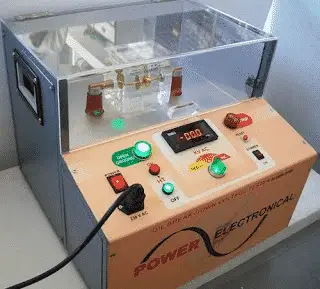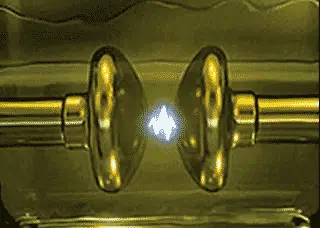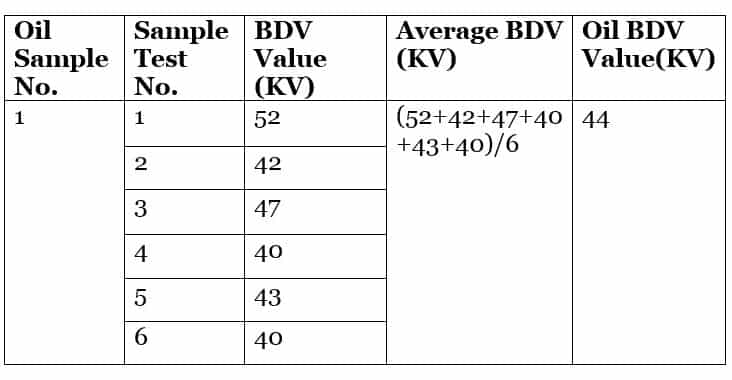The BDV of transformer oil is the breakdown voltage of transformer oil. The BDV or dielectric strength of oil is the maximum voltage withstand capacity of the oil without breakdown. BDV test of transformer oil is very important for the trouble-free operation of the transformer. Therefore, periodic testing of the transformer oil BDV is compulsory to ensure its health.
As per IEC, the minimum BDV of transformer oil should be 30 KV as per transformer oil BDV test standard.

The transformer oil is used in the transformer for insulation and cooling purposes. The different insulating materials have different dielectric strengths. The insulating material should sustain the voltage up to its dielectric strength. If the voltage is increased above the specified dielectric strength of the insulating material, the current starts flowing through it, and eventually, the material gets permanently punctured.
The transformer oil is hygroscopic, i.e., it tends to absorb moisture quickly. The dielectric strength of the oil deteriorates with the absorption of the moisture. That is why the breather filled with silica gel (Moisture absorbent material) is used in the transformer to trap external moisture during breathing in silica gel.
Related Post: Transformer Oil – Testing, Types, and Properties
The core and winding of the power transformer are submerged in transformer oil. The heat generated inside the transformer due to iron loss and copper loss needs to be dissipated outside the transformer to limit the temperature to its safe limit. The heat generated inside the transformer is transferred to oil, and the oil transfers the heat to the outer tank body, and the temperature is dissipated in the atmospheric air. The quality of the transformer oil is of the utmost importance for the reliable operation of a filled transformer.
Related Post: Copper loss in Transformer and How to Calculate it
The reliability of the transformer can be ensured if all the parameters of the transformer oil are as per the standard.
The one very important parameter – The dielectric strength or breakdown voltage (BDV) of the oil must be periodically checked to ensure a trouble-free operation of the transformer.
The dielectric breakdown voltage test is a quick and easy way of determining the contamination in the transformer oil. The water is the major contaminant. However, other contaminants like conductive particles, dirt, debris, insulating particles, and by-products of oxidation and aging of the transformer oil can deteriorate the dielectric strength of the mineral-insulating transformer oil.
Purpose of BDV Test of Transformer Oil
The breakdown voltage test (BDV test) is useful for;
- Predicting the remaining life of the transformer
- Enhancing operational safety
- Preventing equipment fires
- Maintaining transformer reliability
Minimum BDV of Transformer oil
As per IEC standards, the minimum breakdown voltage of transformer oil should be not less than 30 KV. The BDV of transformer oil does not depend on the voltage rating of the transformer. The minimum transformer BDV value for either 11 KV, 22 KV, 33 KV, or 132 KV is the same. The minimum transformer oil BDV value should be 30 KV.
What is BDV Tester?
The sample is taken out from the transformer tank, and the BDV of the oil is checked by the BDV tester. The BDV test kit is basically a high-voltage unit, and the voltage can be regulated from 0–70 KV. The BDV tester has two electrodes separated by a distance of 2.5 mm ( 4.00 mm separation units are also available). The IEC 60156 standard specifies a gap of 2.5 mm between the electrodes.
How to Determine Transformer Oil BDV Value?
As per the Oil BDV Test Procedure, the transformer oil sample should have a minimum temperature of 27°C.
Test Procedure of Transformer Oil BDV
Step-1: Collect the 300-400 ml oil sample of transformer oil from the bottom valve of the transformer in a glass or plastic vessel.
Step-2: Connect the BDV tester to a grounding wire and then to 220VAC, 50Hz, or 110VAC, 60Hz, as specified by the vendor. The BDV tester is a high voltage equipment and you must ensure its earthing before use.
Step-3: Adjust the air gap between the electrodes. It should be 2.5 mm, as per the IEC 60156 standard.
Step-4: Pour the oil sample into the oil pot of the machine.
Step-5: Keep the oil pot in the open air for 5 Minutes so that air bubble, if any, gets out. Further, the vessel should be disturbed to get out of the air bubbles and for homogeneous distribution of impurities.
Step-6: Now, put the oil sample in the machine.
Step-7: Increase the KV at the rate of 2 KV/Sec and observe the oil sample through a glass window.
Step-8: Continuously observe the oil sample through an inspection window while increasing the voltage.
Step-9: Note the KV at which sparking is observed in the oil. The voltage at which sparking is observed is the breakdown voltage of the transformer insulating oil.
Step-10: Take off the cup’s safety lid. Shake the oil to help clean it using a small wooden stick. Wait for 10 minutes before taking the next reading. After 10 minutes, you can repeat the same process.
Step-11: Repeat steps 6,7, 8,9, and 10 for the same sample six times, and record the breakdown KV in each case.
Step -12: Take the average of BDV values recorded in steps 9 and 10.
Step-13: If the oil BDV value is above 30 KV, transformer oil is good.
“If the BDV of transformer oil is measured just after filtration of oil, it will give the erroneous reading because of high temperature. The transformer oil should be cooled down to 27°C temperature before carrying out the BDV test.”

Template for BDV Test Report for Transformer Oil

Interpretation of Results
- New Oil: New oil usually has a BDV value above 70 kV.
- In-service Oil: BDV value over 30 kV shows high insulating strength.
- Low BDV values (less than 30 kV): It indicates contamination, aging, or moisture.
Factors Affecting BDV Value of Transformer Oil
The main factors affecting the breakdown voltage of insulating oil are as follows.
- The water is the major contaminant in transformer oil. Moisture delivers charge carriers and, therefore, decreases the dielectric withstand strength of the oil.
- Aging by-products such as acids also deliver charge carriers through dissociation. Additionally, they are surface-active, decreasing the surface tension. Thus, they support bubble evolution following a decreased dielectric strength.
- Pressure influences bubble evolution, too. With increasing pressure, the breakdown voltage increases. For pressures below the atmospheric pressure, the breakdown voltage should decrease.
- Dry particles of cellulose fibers decrease the breakdown voltage since they support bubble generation.
Transformer Oil BDV Test Standards
Read Next:
Should there be a waiting period after each interval of tests before commencing increasing the voltage again?
But the BDV test shouldn’t be carried out on-site more than 4 to 7 times; it should be conducted in the lab.